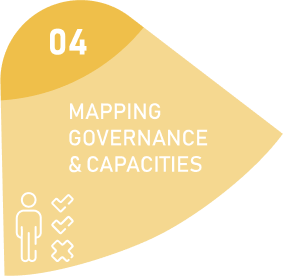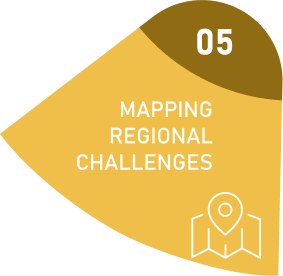By answering guiding questions, you reflect on your HEI’s structure and organisational culture. The analysis of the baseline informs the vision of SD.
The SDS4HEI process model consists of 7 easy-to-follow steps. These steps guide higher education institutions on the many paths towards implementing sustainable development strategies in all core areas.
Ready to uncover how HEIs are pivotal in driving sustainable development and how the SDS4HEI model can guide you and your HEI toward a brighter, greener, just tomorrow? Dive into our print-ready version below, and let’s embark on this journey together!
By answering guiding questions, your HEI is called to reflect on its institutional structure and culture. This baseline informs the formulation of a shared vision of sustainability – a concrete image and the ideal goal to reach. The vision gives meaning to actions and motivates stakeholders in your HEI to act.
Example: ‘A Vision of Preserving what we have’
55 per cent of Bursa Uludağ University’s (BUU) main campus is covered with woods, and 26 per cent is covered with gardens and arable fields. At the heart of BUU’s strategic plans and vision for 2022-2026 is respect for the environment and promoting socioeconomic and cultural development.
Tools
—» Transformation Modes of HEIs (add link to toolbox)
—» Guiding Questions (add link to template)
As you explore the mapping of SD activities conducted across the six core areas, you will gain a comprehensive overview and pinpoint focus areas and trailblazers. Utilise our checklists to describe and organise activities into manageable sets succinctly. By assigning values, you will uncover their impact on the four dimensions of sustainability and assess their alignment with your institution’s vision.
Example: Meaningful Measures to Work Towards a Vision
Most of Bursa Uludağ University’s (BUU) SD actions involve research and education. In line with BUU’s vision of regional environmental protection, the Waste Management Center reduces natural resource consumption and protects wildlife. It is one of the measures in the core area of ‘campus operations’. It strongly impacts the environmental dimension and has a medium impact on the economic dimension of sustainability.
Tools
Guiding Questions (LINK)
Checklist (Table 15 – Table 20)
As you journey towards SD, it is crucial for your HEI to align its efforts with the specific SDG targets relevant to their region. While the 17 SDGs provide a broad framework, the 169 SDG targets offer precise guidance, making SD more achievable. Remember that activities often impact multiple SDG targets, sometimes leading to conflicting priorities. Thus, connecting activities with carefully chosen SDG targets that address regional challenges or opportunities is essential. In Step 7, adjustments can be made to ensure actions are closely aligned with these targets, fostering meaningful progress. Let’s work together to make sustainability a reality in your community!
Example: Innovation Game to Target Relevant SDGs
In the Institut Mines-Télécom Business School’s (IMT-BS) Innovation Game, students work with external partners, such as businesses, to find solutions for regional sustainability challenges. The format ensures a focus on the most relevant regional SDGs, amongst them SDG 4 – Quality Education, SDG 11 – Sustainable Cities & Communities and SDG 17 – Partnerships for the Goals.
Tools:
Linking Activities to SDG targets (—» link to template x)
This step helps you identify the most important capacities necessary to effectively implement a specific SD measure. By analysing the different variables that make up a capacity and the governance arrangements, you can figure out what they need to work on to become a more transformative university. Additionally, key stakeholders can be identified, and governance measures can be planned.
Example: Effective Collaboration and Infrastructure for Waste Management
Stakeholders possess different awareness levels regarding waste management. Bursa Uludağ University (BUU) ensures effective collaboration and participation among different units, student communities, and staff, for example, by designing a decision-making process that incorporates all employees’ and students’ views and suggestions.
The creation and maintenance of the infrastructure also require financial and physical resources. Besides governing, measuring progress and adaptability are further important capacities. While technology integration and data management allow for better measurement, negative results demand adaptation. This is a capacity BUU is currently further developing.
Tools
Guiding Questions (LINK)
Figure 6 Mapping Capacities (LINK)
By mapping regional challenges, for example, expressed in national or regional SD strategies, mentioned in discussions with external stakeholders, reoccurring SDGs, etc., your HEI can gain a better understanding of possible synergies. Instead of targeting regional challenges, your HEI can also focus on supporting regional potentials (e.g. green start-ups, smart specialisation).
Example: Greening an Industrial Region
The Turkish city of Bursa is known as an industrial region. Air pollution and waste management have emerged as central issues and are strategically addressed by legislators and regional sustainability strategies.
With the Waste Management Center, Bursa Uludağ University sets an example in the region. It addresses regional challenges, making a change by educating stakeholders and lowering the university’s negative environmental impact.
Tools
Guiding Questions
SDG Mappings: https://www.sdgmapping.ch/
Map of Country Progress: https://dashboards.sdgindex.org/map
As you align and visualise the key findings of the internal and external mappings, your HEI can streamline its endeavours while empowering involved actors to make informed decisions and take purposive actions. There are several ways to visualise the most pressing regional SD challenges and core findings, including infographics, maps, data visualisation tools, or network visualisations. This process entails thoughtful reflection on the insights gained and facilitates internal and external communication.
Example: Give Up Smoking – A Transdisciplinary Activity
On World Chronic Obstructive Pulmonary Disease (COPD) Day, Bursa Uludağ University organised a ‘Give Up Smoking’ activity. With this event, in addition to discussing healthy lifestyle methods, a reduction in cigarette butt waste was supposed to be achieved. Operational steps like this aim to contribute to the Waste Management Center’s leadership in the region’s environmental protection and sustainability goals.
Tools
Guiding Questions (LINK)
Example of an interactive card: https://verwaltungslandkarte-nachhaltigkeit.uni-hamburg.de/index.html
Finally, the gap analysis helps you identify synergies and gaps and ensure the overarching vision is harmoniously realised. As part of the gap analysis, HEIs need to realign their actions to regional targets. In so doing, HEIs should limit themselves to the most important targets.
Example: Creating Added Value for the Region
The focus areas of Bursa Uludağ University (BUU) include respect for the environment, socioeconomic and cultural development, and sustainability awareness. In the context of the Turkish city of Bursa, there is an alignment with the regional challenges of air pollution and waste management. In the future, partnerships with external stakeholders will be fostered to further strengthen the impact on the region and target the other dimensions of sustainability.
Tools
Guiding Questions (LINK)
Tools for Theory of Change







